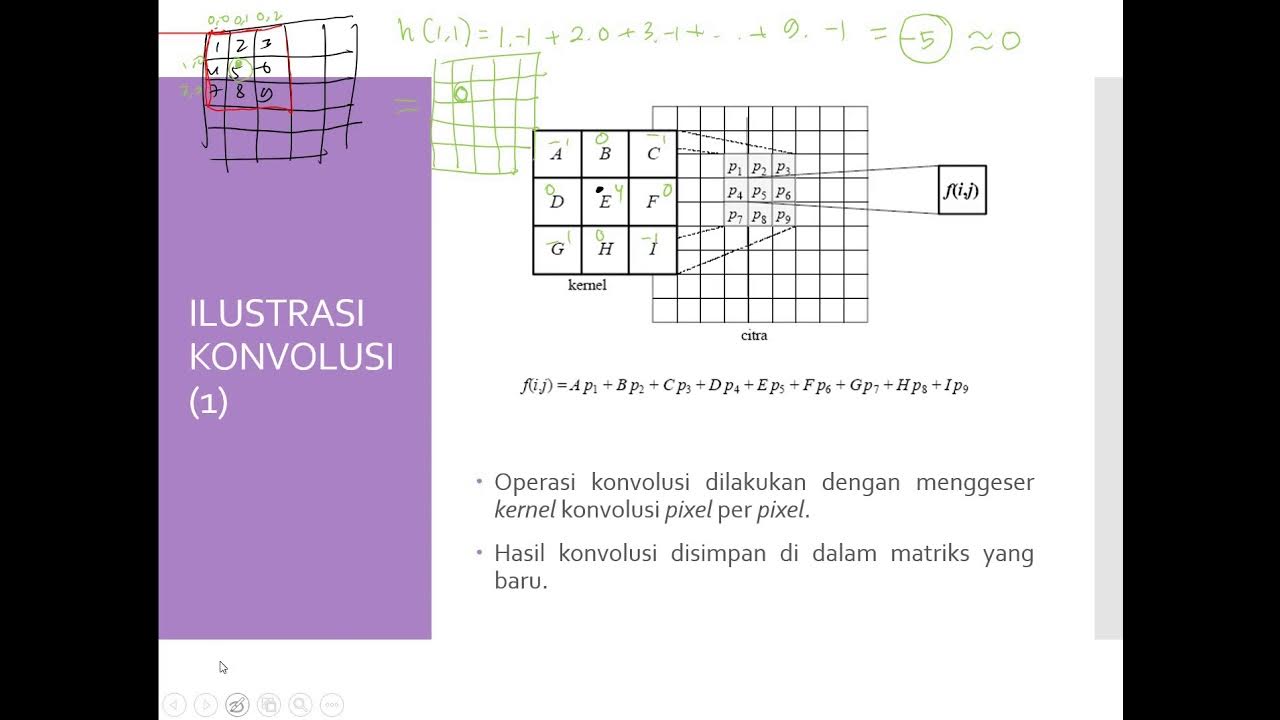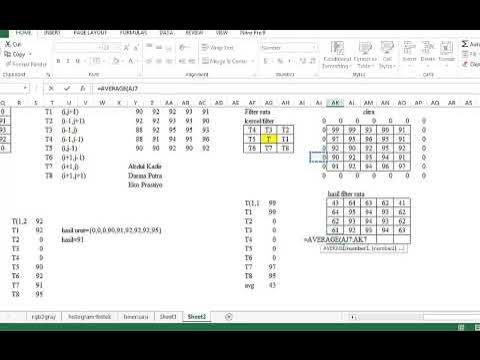Konvolusi Pengolahan Citra Digital | Secara Garis Besar #1
Summary
TLDRIn this video, the concept of convolution in image processing is explained in a simplified manner. The speaker breaks down the process of convolution, where two matrices (an image and a channel) interact through mathematical operations like multiplication, addition, and division. This operation is repeated over the entire image to produce a new matrix or image. The video also introduces different filters like the smoothing filter (which blurs images) and the Laplacian of Gaussian filter (which detects edges). Viewers are encouraged to understand convolution at a high level before diving into more advanced topics.
Takeaways
- 😀 Convolution is a mathematical operation that involves two matrices: the image matrix and the kernel matrix.
- 😀 The convolution operation consists of multiplying corresponding elements of the image and the kernel, summing the results, and dividing by the total sum of the kernel elements.
- 😀 The result of the convolution operation is stored in a new matrix, which represents the transformed image.
- 😀 The kernel matrix can be visualized as a small filter applied to the image, affecting each pixel in the image based on its surrounding values.
- 😀 To perform convolution, the kernel is often rotated 180 degrees, though for symmetric kernels, this step can be skipped.
- 😀 After performing the convolution for one section of the image, the new value is placed in the corresponding position of the output image.
- 😀 The process of convolution is repeated for all parts of the image, covering it entirely and producing the final result.
- 😀 Convolution can be used for various types of image filtering, including noise reduction (via smooth filters) and edge detection (via Laplacian of Gaussian filters).
- 😀 A smooth filter reduces noise in an image by averaging pixel values, making the image appear blurrier but cleaner from noise.
- 😀 The Laplacian of Gaussian (LoG) filter is a more advanced filter that helps detect edges by highlighting areas of rapid intensity change in an image.
- 😀 The video encourages viewers to understand convolution conceptually before diving into more complex details, which will be covered in further lessons.
Q & A
What is convolution in the context of image processing?
-Convolution is a mathematical operation that involves two matrices: an image matrix and a kernel (or channel) matrix. It is used to process images by applying operations like multiplication and summation on overlapping sections of the image and kernel, typically to detect features or apply filters.
Why is it important to rotate the kernel matrix before applying convolution?
-The kernel matrix is typically rotated by 180° before being applied to the image in convolution. This step ensures that the operation aligns correctly, but in cases where the kernel is symmetric, this step can be skipped.
What is the purpose of dividing the sum of the multiplication results by the total sum of the kernel values?
-Dividing the sum of the multiplication results by the sum of all values in the kernel ensures that the output of the convolution is normalized, preventing overly bright or dark results based on the kernel values.
How does the convolution operation affect the resulting image?
-The convolution operation transforms the image by applying filters or detecting features like edges. The operation involves shifting the kernel over the image and applying mathematical operations at each position, which results in a transformed image that highlights certain properties like edges or smoothness.
What is a 'smooth filter' in convolution?
-A smooth filter, also known as a blur filter, is a simple kernel used in convolution that reduces image noise by averaging pixel values. While it smoothens the image, it can also make the image appear blurrier.
What is the advantage of using a Laplacian of Gaussian filter in convolution?
-The Laplacian of Gaussian (LoG) filter is used in convolution to detect edges in an image. It combines the Laplacian operator (which detects changes in intensity) with a Gaussian blur to enhance edge detection, making it useful for identifying boundaries within an image.
Why does the script mention that convolution is not difficult once you understand the basics?
-The script highlights that once you understand the basic operations of convolution, such as multiplying, adding, and dividing pixel values, the process becomes straightforward. It is simply a matter of repeating the operations over the entire image until all regions are covered.
What is the role of the 'channel' in the convolution process?
-The 'channel' in the convolution process refers to the kernel matrix that interacts with the image matrix. It is used to apply specific operations to the image, such as smoothing or edge detection, depending on its values and structure.
How do you determine the value of each pixel in the resulting image after convolution?
-The value of each pixel in the resulting image is determined by performing element-wise multiplication between the overlapping section of the image and the kernel, summing the results, and then normalizing the result (often by dividing by the sum of the kernel's values).
What happens if we apply a convolution with a smooth filter to an image with noise?
-Applying a smooth filter to an image with noise will reduce the noise, making the image less grainy. However, it may also introduce blurriness, which is why smooth filters are also referred to as blur filters.
Outlines

Esta sección está disponible solo para usuarios con suscripción. Por favor, mejora tu plan para acceder a esta parte.
Mejorar ahoraMindmap

Esta sección está disponible solo para usuarios con suscripción. Por favor, mejora tu plan para acceder a esta parte.
Mejorar ahoraKeywords

Esta sección está disponible solo para usuarios con suscripción. Por favor, mejora tu plan para acceder a esta parte.
Mejorar ahoraHighlights

Esta sección está disponible solo para usuarios con suscripción. Por favor, mejora tu plan para acceder a esta parte.
Mejorar ahoraTranscripts

Esta sección está disponible solo para usuarios con suscripción. Por favor, mejora tu plan para acceder a esta parte.
Mejorar ahora5.0 / 5 (0 votes)






